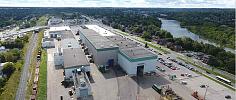- FMA
- The Fabricator
- FABTECH
- Canadian Metalworking
By the numbers: Major equipment buying trends show long-term volatility
Manufacturing purchases often experience a lag effect after a recession, where improving market conditions don’t trigger increased spending until well into the recovery.
- By Canadian Metalworking
- March 25, 2014
The Canadian Machine Tool Dealer’s Association compiles extensive statistics on machining and fabricating equipment purchases in the Canadian market, showing some interesting trends. Twice in the past decade, in 2002 and in 2010, soft markets were followed by frenzied buying activity with a slow softening of demand post-peak, both in 2005 and in 2011.
The graph illustrates the classic lag effect in manufacturing industries, where improving market conditions after a recession don’t trigger increased capital spending until well into the recovery. At that point, expanding orders required quick expansion and modernization, creating a sudden surge in units sold.
It’s a workable strategy for general purpose fabricating equipment and machine tools, but higher value specialized equipment is less likely to be in stock or available from manufacturers with short lead times.
Metal forming equipment shipments are historically about half the dollar value of machining equipment, not due to volumes shipped, but the lower per unit cost of most fab equipment compared to machine tools. The loss of much stamping business over the last 20 years has taken big presses out of the equipment mix, further widening the dollar gap between “fab” and “chip”.
As the “art to part” timeline shortens, it will be necessary to have machine capability on the floor, ready to make parts to win future business. With interest rates predicted to rise toward the end of 2014, this might be the year to upgrade and add capacity.
subscribe now


Keep up to date with the latest news, events, and technology for all things metal from our pair of monthly magazines written specifically for Canadian manufacturers!
Start Your Free SubscriptionAbout the Author
- Industry Events
MME Saskatoon
- May 28, 2024
- Saskatoon, SK Canada
CME's Health & Safety Symposium for Manufacturers
- May 29, 2024
- Mississauga, ON Canada
DiPaolo Machine Tools Open House 2024
- June 4 - 5, 2024
- Mississauga, ON Canada
FABTECH Canada
- June 11 - 13, 2024
- Toronto, ON Canada
Zoller Open House & Technology Days 2024
- June 12 - 13, 2024
- Ann Arbor, MI





















